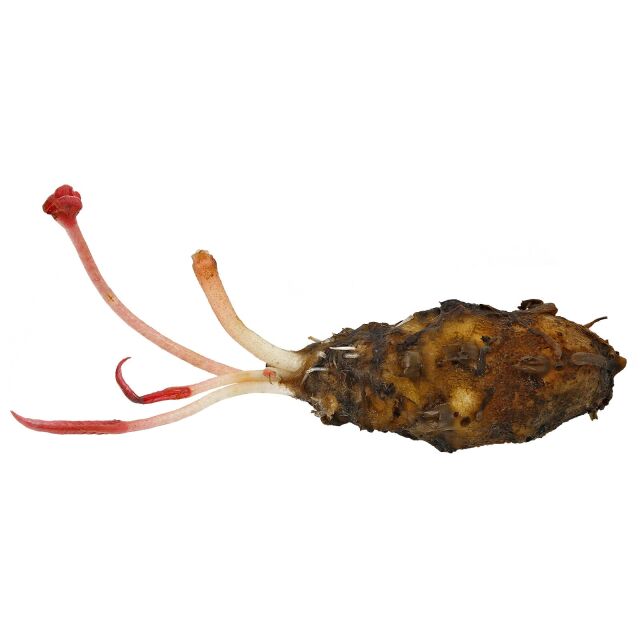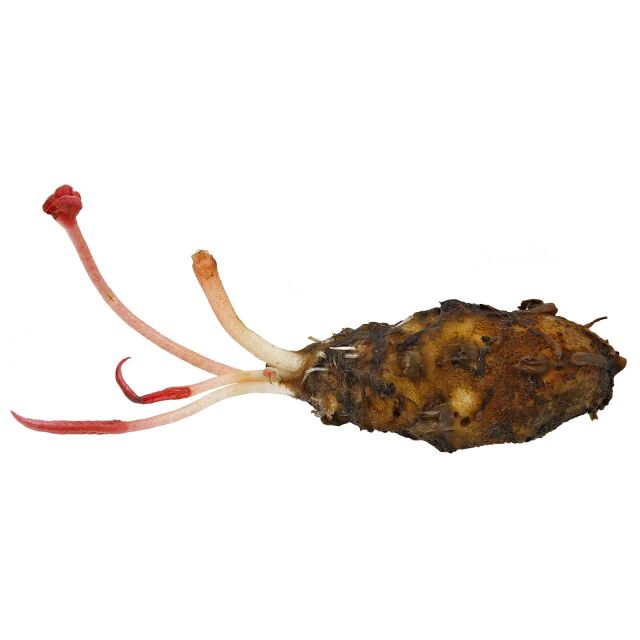


Barclaya longifolia
- Magnificent rosette plant
- Wavy, elongate leaves
- Mauve leaf undersides
- Relatively rare in trade
Sign in or Register
Item question
We’re here for you!
Please enter your question and e-mail and we’ll contact you as soon as possible. It usually takes us up to 24 hours during business days to respond.
Thank you for your question!
Thank you, we’ll get in touch!
Close window
You already sent us a question.
Please wait a few minutes
Description
The Long-leaf Barclaya is a classical aquarium plant, however it has become quite rare in the hobby in recent years. This magnificent underwater plant belongs to the Waterlily family (Nymphaeaceae) and is native to Southeast Asia where it occurs in clear streams with soft, acid water. Its elongate, almost arrow-shaped, wavy, soft leaves get more than 30 cm long and sit in a rosette on a tuber-like or elongate rhizome. There are olive-green or red colour variants; in both cases the leaf underside is a mauve colour. Our plants are partly delivered as tubers without leaves that will sprout in the aquarium. They may be green as well as red variants.
Medium lighting is sufficient for Barclaya longifolia; it grows best with nutrient-rich bottom (e.g. a type of Aquasoil or gravel with a little loam), soft to medium hard water and higher temperatures (optimum: 25-28 °C, tolerance range: 18-30 °C). The delicate leaves are prone to damage by snails. This plant is primarily propagated by sowing; it also develops fruits with seeds when the flowers remain below the water surface. After periods of lush growth and flowering the plant may decline in growth for several weeks; during this time it should not be replanted.
Barclaya longifolia looks pretty in not too small tanks, as solitary plant or small group in the midground or background. With its elongate, wavy leaves, it resembles certain larger Cryptocoryne species.
Barclaya longifolia, which belongs to the Nymphaceae family, is found in large parts of Southeast Asia. However, this plant does not form any floating leaves even though it is technically spoken a water lily. Its elongated, reddish to green, wavy leaves make it look like a Cryptocoryne at first glance, at least as long as the plant is still young. However, the plant soon grows to a size comparable to a large Echinodorus. There is a red and a green variety, the latter with a reddish leaf underside. The green variety grows a little larger than the red one.
Like other Nymphaeaceae, Barclaya longifolia can be kept small for a longer time when its roots are restricted, e.g. by planting into a small pot. In general, this Barclaya is a relatively undemanding plant as long as it gets sufficient light and warm water (not under 24 °C). (read more)
| Complete botanical name | Barcláya longifólia Wall. |
| Family | Nymphaeaceae |
| Genus | Barclaya |
| Difficulty | medium |
| Usage | Background, Midground |
| Growth | medium |
| pH value | 5 - 7 |
| Temperature tolerance | 18 - 30°C |
| Carbonate hardness | 2 - 20°dKH |
| General hardness | 0 - 30°dGH |
| Propagation | Seeds, Splitting, cutting off daughter plants |
| Can grow emersed? | no |
| Source | Flowgrow |
| Complete botanical name |
| Barcláya longifólia Wall. |
| Family |
| Nymphaeaceae |
| Genus |
| Barclaya |
| Difficulty |
| medium |
| Usage |
| Background, Midground |
| Growth |
| medium |
| pH value |
| 5 - 7 |
| Temperature tolerance |
| 18 - 30°C |
| Carbonate hardness |
| 2 - 20°dKH |
| General hardness |
| 0 - 30°dGH |
| Propagation |
| Seeds, Splitting, cutting off daughter plants |
| Can grow emersed? |
| no |
| Source |
| Flowgrow |
General information
Please choose a variant to see more information.
| Item no. |
|
| EAN | |
| Weight | |
| Shipping weight |
Customers ask customers
You have questions about this product? Ask other customer or our support team about this product!